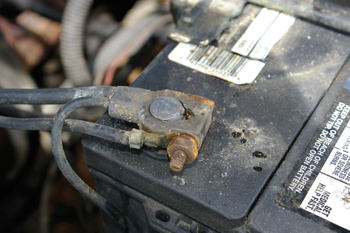As durable as many auto parts are these days, most vehicles will have their battery replaced at least three or four times during their lifetime. Average battery life is still only about four years, and as little as three years in hot climates. For maximum life in all types of climates, batteries must be kept fully charged and not allowed to run down or to remain discharged for a long period of time.
 A common cause of premature battery failure is chronic undercharging. Sulfate that forms on the cell plates can age the plates and causes a permanent loss of storage capacity. That’s why a good charging system is so important to maintain the battery’s charge. Vibration can also kill a battery by causing cracks to form in the cell connectors and separators inside the battery. Loss of water from the electrolyte due to excessive temperatures, evaporation or overcharging can also damage battery cell plates.
A common cause of premature battery failure is chronic undercharging. Sulfate that forms on the cell plates can age the plates and causes a permanent loss of storage capacity. That’s why a good charging system is so important to maintain the battery’s charge. Vibration can also kill a battery by causing cracks to form in the cell connectors and separators inside the battery. Loss of water from the electrolyte due to excessive temperatures, evaporation or overcharging can also damage battery cell plates.
All lead-acid car batteries produce hydrogen gas when charging. This is partially a function of the metal alloys used in the battery grids. In maintenance-free batteries, the grids contain less antimony or a calcium or lead-strontium alloy that greatly reduces gassing and water loss when the battery is charging. That’s why most maintenance-free batteries have sealed tops. This makes it impossible to check the water level inside unless the case is translucent and you can see the water level in the cells. Even then, there are no provisions for adding make-up water if the water level is low. Prying open the top can damage the battery and void the warranty.
Batteries that still have removable caps and are classified as “maintenance-accessible,” can have water added to individual cells if the level is low. Use clean distilled water only (ordinary tap water contains dissolved salts and minerals that will contaminate the electrolyte).
Acid should NEVER be added to a battery, unless it is a dry-charge motorcycle battery that require acid to be added to activate the cells.
Some batteries do not have free liquid electrolyte inside. Absorbed Glass Mat (AGM) batteries hold the electrolyte in sponge-like fiberglass mats sandwiched between the positive and negative cell plates. This almost eliminates evaporation and gassing, as well as the risk of spillage. The AGM design also makes a battery more resistant to vibration, which improves durability and reduces the risk of premature failure. Some of these batteries have a “spiral wound” cell construction rather than rectangular cell plates to increase the surface area and storage capacity of the battery.
AGM batteries are often used in high-load applications where there are increased electrical demands on the battery. AGM batteries typically have less internal resistance than other batteries, and experience less heat buildup when discharging and while being recharged. They also hold their charge better than a wet cell battery, losing only about 1 percent to 3 percent of their charge per month when not being used.
Most experts advise replacing an AGM battery with another AGM battery when a new battery is needed. A less expensive conventional battery may not handle the same loads as well as an AGM battery, which may cause the new battery to fail prematurely. AGM batteries can also be sold as an upgrade for a conventional battery.
AGM batteries also have special charging requirements. The charging voltage should not exceed 14.8 volts even for short period of time, otherwise it may damage the battery. AGM batteries can handle very high charging currents as long as the voltage is kept within safe limits. Many newer “smart” battery chargers take this into account, or have a special setting for AGM batteries. Slow charging at a reduced amp rate is usually best for all types of batteries.
If a battery will not accept or hold a charge, or tests bad, it has reached the end of the road. There is no way to rejuvenate an old sulfated battery or a battery that has internal shorts, opens or cell damage.
The condition of a battery can be checked with a conductance tester or load tester. For accurate test results, the battery should be fully charged and the battery must be tested at the recommended load (usually half its CCA amp rating). If a battery tests bad, it needs to be replaced.
A replacement battery must be the same group size (dimensions and post configuration) as the original, the same type of battery (or better) than the original (replace AGM with AGM), and the same or higher Cold Cranking Amp (CCA) rating as the original battery. Most V6 and V8 engines require 600 CCA for reliable cold weather starting. Many diesel pickup trucks have a dual battery setup for added cranking power, so if one battery has failed it is usually a good idea to replace both batteries at the same time.
A new battery should be fully charged before it is installed. Batteries are charged at the factory, but can discharge over time as they sit on the shelf.
Other items a battery customer may require include new battery cables and/or engine ground straps. The battery cables should be inspected, and replaced if found to be damaged, loose or badly corroded. A new battery can’t crank the engine normally or maintain its charge if the cables or ground connections are no good.











